
Psychology: The Beginnings
Dr. C. George Boeree

Psychology: The Beginnings
Dr. C. George Boeree
Psychology as we know it didn't suddenly appear on the intellectual scene. It is impossible to say just when it began, or who was responsible for it. Instead, we can only point to a number of currents that take us from philosophy and the natural sciences into something recognizably psychological. This chapter looks at two of these "primordial" currents -- associationism as the beginnings of a cognitive theory, and the introduction of quantification in the forms of psychophysics and intelligence testing.
Associationism
Associationism is the theory that the mind is composed of elements -- usually referred to as sensations and ideas -- which are organized by means of various associations. Although the original idea can be found in Plato, it is Aristotle who gets the credit for elaborating on it. Aristotle counted four laws of association when he examined the processes of remembrance and recall:
1. The law of contiguity. Things or events that occur close to each other in space or time tend to get linked together in the mind. If you think of a cup, you may think of a saucer; if you think of making coffee, you may then think of drinking that coffee.
2. The law of frequency. The more often two things or events are linked, the more powerful will be that association. If you have an eclair with your coffee every day, and have done so for the last twenty years, the association will be strong indeed -- and you will be fat.
3. The law of similarity. If two things are similar, the thought of one will tend to trigger the thought of the other. If you think of one twin, it is hard not to think of the other. If you recollect one birthday, you may find yourself thinking about others as well.
4. The law of contrast. On the other hand, seeing or recalling something may also trigger the recollection of something completely opposite. If you think of the tallest person you know, you may suddenly recall the shortest one as well. If you are thinking about birthdays, the one that was totally different from all the rest is quite likely to come up.
Association, according to Aristotle, took place in the "common sense." It was in the common sense that the look, the feel, the smell, the taste of an apple, for example, came together to become the idea of an apple.
For 2000 years, these four laws were assumed to hold true. St. Thomas pretty much accepted it lock, stock, and barrel. No one, however, cared that much about association. It was seen as just a simple description of a commonplace occurrence. It was seen as the activity of passive reason, whereas the abstraction of principles or essences -- far more significant to philosophers -- was the domain of active reason.
During the enlightenment, philosophers began to become interested in the idea again, as a part of their studies of vision as well as their interest in epistemology. Hobbes understood complex experiences as being associations of simple experiences, which in turn were associations of sensations. The basic means of association, according to Hobbes, was coherence (continguity), and the basic strength factor was repetition (frequency).
John Locke, rejecting the possibility of innate ideas, made his entire system dependent on association of sensations into simple ideas. He did, however, distinguish between ideas of sensations and ideas of reflection, meaning active reason. Only by adding simple ideas of reflection to simple ideas of sensation could we derive complex ideas. He also suggested that complex emotions derived from pain and pleasure (simple ideas) associated with other ideas.
It was David Hume who really got into the issue. Recall that he saw all experiences as having no substantial reality behind them. So whatever coherence the world (or the self) seems to have is a matter of the simple application of these natural laws of association. He lists three:
1. The law of resemblance -- i.e. similarity.
2. The law of contiguity.
3. The law of cause and effect -- basically contiguity in time.
David Hartley (1705-1757) was an English physician who was responsible for making the idea of associationism popular, especially in a book called Observations of Man. His emphasis was on the law of contiguity (in time and space) and the law of frequency. But he added an idea he got from the famous Isaac Newton: This association was a matter of tuned "vibrations" within the nerves! His basic ideas are very similar to those of D. O. Hebb in the twentieth century.
James Mill (1773-1836) also elaborated on Hume's associationism. The elder Mill saw the mind as passively functioning by the law of contiguity, with the law of frequency and a law of vividness "stamping in" the association. His emphasis on the law of frequency as the key to learning makes his approach very similar to the behaviorists in the twentieth century. But he is most famous for being the father of...
John Stuart Mill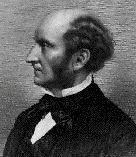
"That so few now dare to be eccentric marks the chief danger of the time."
John Stuart Mill was born May 20, 1806 in London. His father was James Mill, an historian, philosopher, and social theorist. His mother was Harriet Barrow, and seems to have had next to no influence on him! His father decided to use the principles of utilitarianism and associationism (in consultation with his good friend, Jeremy Bentham) to educate John "scientifically."
This seemed to work quite well: John began learning Greek at three, Latin at eight. At 14, he studied French, mathematics, and chemistry in France. At 16, he began working as a clerk for his father at India House, headquarters of the East India Company. By 18, John was publishing articles on utilitarian philosophy!
But at 20, he had a nervous breakdown, which he describes in his Autobiography (1873). He attributed it, no doubt rightly, to his rigid education.
In 1830, he met Harriet Taylor, a married woman. He remained loyal to her until her husband died 21 years later (!), at which point they married. Sadly, she died only seven years later.
During this time, he served as an examiner for the East India Company. He also served as a liberal member of Parliament from 1865 to 1868. ("Conservatives are not necessarily stupid, but most stupid people are conservatives.") He died at his home in Avignon, France, on May 8, 1873.
His best known work is On Liberty, published in 1859. His most important work as far as science and psychology are concerned is A System of Logic, first printed in 1843 and going through many more editions through the rest of the 1800's.
He began with the basics established by Hume, his father James Mill, and others:
1. A sensory impression leaves a mental representation (idea
or
image);
2. If two stimuli are presented together repeated, they create
an association in the mind;
3. The intensity of such a pairing can serve the same function
as repetition.
But he adds that associations can be more than the simple sum of their parts. They can have attributes or qualities different from the parts in the same way that water has different qualities than the hydrogen and oxygen that compose it. So J. S. Mill's associationism is more like "mental chemistry" than mental addition.
J. S. Mill agrees with Hume that all we can know about our world and ourselves is what we experience, but notes that generalization allows us to talk with some confidence about things beyond experience. And he believed that there are real causes for consistent phenomena!
This is often called phenomenalism. He defines matter, for example, as "the permanent possibility of sensation." This persepctive would have profound effects on 20th century logical positivism (Wittgenstein, Ayer, Schlick, Carnap, and others) who provided the philosophical foundation for most behaviorists.
He promotes a scientific method that focuses on induction: Generalizations from experiences lead to theory, from which we then develop alternative hypotheses; We go on to test these hypotheses by observation and experiment, the results of which allow us to improve theory, and so on. This circular notion of scientific progress is known as the hypothetico-deductive method. In this way we slowly build up laws of nature in which we can be increasingly confident. This method proved to be very popular among the scientists of his day.
He more specifically outlines five procedures for establishing causation. The simpler ones go like this:
1. The method of agreement: If a phenomenon occurs in two different situations, and those two situations have only one thing in common, that "thing" is the cause (or effect) of the phenomenon.
2. The method of differences: If a phenomenon occurs in one situation but not in another, and those two situations have everything in common except for one thing, then that "thing" is the cause (or effect) of the phenomenon.
3. The method of concomitant variations: If one phenomenon varies consistently with the variations of another phenomenon, one is the cause or effect, or is otherwise involved in the causation, of the other. This, of course, is the foundation for correlation which, although it cannot establish the direction of causality, does indicate some causal relationship.
When it comes to psychology, he argued that it could indeed someday become a science, but was unlikely to ever be an exact science. Predicting the behavior of human beings may be forever beyond our abilities, leaving us to limit ourselves to talking about tendencies.
His utilitarianism recognizes that happiness is not restricted to physical pleasures (or the avoidance of pain), that there may be different kinds or qualities of happiness. "It is better to be a human being dissatisfied than a pig satisfied; better to be Socrates dissatisfied than a fool satisfied." So, although we certainly begin as simple pleasure-seeking creatures, over time we can acquire far more humanistic motivations. Ultimately, this means that high moral values can be taught, and are not dependent on innate qualities of character.
When looking at social issues, J. S. Mill applies his expanded utilitarianism: Does a certain institution add to human welfare? Or are there better alternatives? He argues, for example, that women should be allowed to vote because women's self-interests can add balance to men's self-interests, and lead to a better society. He argues for personal freedom because it allows creative individuals to better contribute to society. On the other hand, he notes that free-market capitalism tends to result in inequity and poverty, and we would be better served by some form of socialism.
Thomas Brown (1778-1820) of the Scottish School puts the finishing touches to associationism: His laws of suggestion (i.e. association) were resemblance, contrast, and nearness in space and time, just like Aristotle's. He added a set of secondary laws -- duration, liveliness, frequency, and recency -- that strengthened suggestions. Then he considered as well the degrees of coexistence with other associations, constitutional differences of mind or temperament, differing circumstances of the moment, state of health or efficiency of the body, and prior habits. Finally, he understood association as an active process of an active, holistic mind.
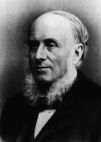 Alexander Bain
(1818-1903), a lifelong friend of John Stuart
Mill, connected associationism with physiology. Accepting the law
of contiguity, similarity, and frequency, he viewed them, as had
Hartley,
as neurological. He added the law of compound association, which
says that most associations are among whole clusters of other
associations.
And he added the law of constructive association, which says that we
can
also actively, creatively, add to our associations ourselves.
Alexander Bain
(1818-1903), a lifelong friend of John Stuart
Mill, connected associationism with physiology. Accepting the law
of contiguity, similarity, and frequency, he viewed them, as had
Hartley,
as neurological. He added the law of compound association, which
says that most associations are among whole clusters of other
associations.
And he added the law of constructive association, which says that we
can
also actively, creatively, add to our associations ourselves.
One of Bain's basic principles is immortalized as the Spencer-Bain principle: The frequency or probability of a behavior rises if it is followed by a pleasurable event, and decreases if it is followed by a painful event. This is, of course, the same principle that the behaviorists would elaborate on a century later.
Bain has an even larger role in the history of psychology. First, he is often given the credit of having written two of the earliest textbooks in psychology -- The Senses and the Intellect (1855) and Emotions and the Will (1859), both of which went through many editions, and were used, for example, by William James. He also founded the first English-language psychological journal, called Mind, in January of 1876.
Hermann Ebbinghaus
The preceding people were essentially philosophers, not scientists. The first psychologist who made an effort to study association scientifically was Hermann Ebbinghaus.
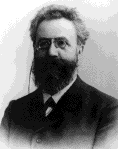 Hermann Ebbinghaus was
born on January 23, 1850, in Barmen, Germany.
His father was a wealthy merchant, who encouraged his son to
study.
Hermann attended the University of Halle and the University of Berlin,
and received his doctorate from the University of Bonn in 1873.
While
traveling through Europe, he came across a copy of Fechner’s Elements
of
Psychophysics, which turned him on to psychology.
Hermann Ebbinghaus was
born on January 23, 1850, in Barmen, Germany.
His father was a wealthy merchant, who encouraged his son to
study.
Hermann attended the University of Halle and the University of Berlin,
and received his doctorate from the University of Bonn in 1873.
While
traveling through Europe, he came across a copy of Fechner’s Elements
of
Psychophysics, which turned him on to psychology.
Ebbinghaus worked on his research at home in Berlin and published a book called On Memory: An Investigation in Experimental Psychology in 1885. Basically, his research involved the memorization of nonsense syllables, which consisted of a consonant, a vowel, and another consonant. He would select a dozen words, then attempt to master the list. He recorded the number of trials it took, as well as the effects of variations such as relearning old material, or the meaningfulness of the syllables. The results have been confirmed and are still valid today.
He also wrote the first article on intelligence testing of school
children,
and devised a sentence completion test that became a part of the
Binet-Simon
test. He also published textbooks on psychology in 1897 and 1902
that were very popular for many years. Hermann Ebbinghaus died in
1909, a clear precursor to today’s cognitive movement.
The laws of association would continue to have a powerful influence in psychology. The Behaviorists, of course, focused on stimulus-stimulus and stimulus-response associations. The Gestalt psychologists elaborated on the various associations they termed the laws of Prägnanz. Among the cognitive psychologists, there are various theories of semantic association. And the physiological psychologists talk about the neurological bases for association. The idea appears to be here to stay. But then, as Greek and Medieval philosophers knew, association is just a simple description of a commonplace occurrance!
Psychophysics
Again and again, philosophers stated unequivocally that psychology could never be a science. The activities and the contents of the mind could not be measured, and therefore an objectivity such as that achieved in physics and chemistry was out of reach. Psychology would forever remain subjective!
This would finally change in the early 1800s. Ernst Weber (1795 to 1878) was born June 24 in Wittemburg, Germany, the third of 13 children! He received his doctorate from the University of Leipzig in 1815, in physiology. He began teaching there right after graduation, and continued until he retired in 1871.
His research was predominantly concerned with the senses of touch and kinesthesia (the experience of muscle position and movement). He was the first to clearly demonstrate the existence of kinesthesia, and showed that touch was actually a conglomerate sense composed of senses for pressure, temperature, and pain.
His chosen interests led him to certain techniques: First, there is the two-point threshold, which is a matter of measuring the smallest distance noticeable to touch at various parts of the body. For example, the tongue had the smallest threshold (1 mm), and the back had the largest (60 mm).
A second technique involved kinesthesia: Just-noticeable difference is the smallest difference in weight a person is capable of perceiving through holding two things. He discovered that the just-noticeable difference was a constant fraction of the weights involved. If you are holding a 40 pound weight in one hand, you will be able to recognize that a 41 pound weight in the other hand is in fact different. But if it were a 20 pound weight, you could detect a mere half pound difference! In other words, as regards weight, we could recognize a 1/40 difference, whatever the weights.
This is known as Weber’s Law, and is the first such “law” relating a physical stimulus with a mental experience.
Gustav Fechner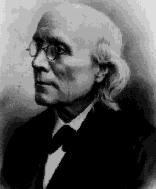
Gustav Fechner was born April 1, 1801. His father, a village pastor, died early in Gustav’s childhood, so he, with his mother and brother, went to live with their uncle. In 1817, at the age of 16, he went off to study medicine at the University of Leipzig (were Weber was teaching). He received his MD degree in 1822 at the age of 21.
But his interests moved to physics and math, so he made his living tutoring, translating, and occasionally lecturing. After writing a significant paper on electricity in 1831, he was invited to become a professor of physics at Leipzig. There, he became friends with a number of people, including Wilhelm Wundt, and his interests moved again, this time to psychology, especially vision.
In 1840, he had a nervous breakdown, and he had to resign his position due to severe depression. At his worst, he stayed in his rooms alone, avoiding light which hurt his eyes, and even painted his room black. While lying in bed one morning, October 22, 1850, he suddenly realized that it was indeed possible to connect the measurable physical world with the mental world, supposed to be inaccessible to scientific investigation! As his condition improved, he returned to writing and performing endless experiments, using mostly himself as a subject.
Like many people at the time, he found Spinoza’s double-aspectism convincing and found in panpsychism something akin to a personal religion. Using the pseudonym Dr. Mises, he wrote a number of satires about the medicine and philosophy of his day. But he also used it to communicate, often in an amusing way, his spiritual perspective. As a panpsychist, he believed that all of nature was alive and capable of awareness of one degree or another. Even the planet earth itself, he believed, had a soul. He called this the day-view, and opposed it to the night-view of materialism.
Further, he felt that our lives come in three stages -- the fetal life, the ordinary life, and the life after death. When we die, our souls join with other souls as part of the supreme soul.
It was double-aspectism that led him to study (and name) psychophysics, which he defined as the study of the systematic relationships between physical events and mental events. In 1860, he topped his career by publishing the Elements of Psychophysics.
In this book, he introduced a mathematical expression of Weber’s Law. The expression looked like this...
*R /R = k
which means that the proportion of the minimum change in stimulus detectable (*R) to the strength of the stimulus (R) is a constant (k). (R is for the German Reiz, meaning stimulus.) Or...
S = k log R
where S is the experienced sensation.
Fechner died November 28, 1887.
What Weber and Fechner showed that makes them far more significant than just Weber’s Law is that psychological events are in fact tied to measurable physical events in a systematic way, which everyone had thought impossible. Psychology could be a science after all!
The second quantitative breakthrough would be the measurement of something far more complex, far more "psychological:" intelligence. We owe this to two great minds in particular: Sir Francis Galton in England and Alfred Binet in France.
Sir Francis Galton
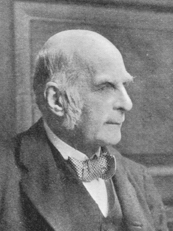 Francis Galton was born
February 16, 1822 near Birmingham, England.
He was the youngest of 7 children, and first cousin of Charles
Darwin.
His father, a wealthy banker, insisted on educating Francis at home,
especially
considering that Francis could read at 2 and a half years old!
Francis Galton was born
February 16, 1822 near Birmingham, England.
He was the youngest of 7 children, and first cousin of Charles
Darwin.
His father, a wealthy banker, insisted on educating Francis at home,
especially
considering that Francis could read at 2 and a half years old!
Later in childhood, he was sent off to boarding school, which he despised and criticized even in adulthood. At 16, he went to medical school at King’s College at Oxford. He finished his degree at Cambridge in 1843, at 21.
His father died, leaving Galton a wealthy young aristocrat. He traveled extensively and became a member of the Royal Geographical Society, for which he developed maps of new territories and accounts of his adventures. He became president of that organization in 1856.
Galton had a penchant for measuring everything -- extending even to the behinds of women he encountered in his travels in Africa (something he had to do from a distance, of course, by means of triangulation). This interest in measurement led to his invention of the weathermap (including highs, lows, and front -- terms he introduced), and to suggesting the use of fingerprints to Scotland Yard.
His obsession eventually led to his efforts at measuring intelligence. In 1869, he published Hereditary Genius: An Inquiry into its Laws and Consequences, in which he demonstrates that the children of geniuses tend to be geniuses themselves.
In 1874, he produced English Men of Science: Their Nature and Nurture, based on long surveys passed out to thousands of established scientists. In this volume, he noted that, although the potential for high intelligence is still clearly inherited, it also needed to be nurtured to come to full fruition. In particular, the broad, liberal education provided by the Scottish school system proved far superior to the English school system he hated so much.
In 1883, he wrote Inquiries into Human Faculty and its Development. This would be the first time anyone compared identical and fraternal twins, a method now considered ideal when investigating nature vs nurture issues.
In 1888, he published Co-Relations and Their Measurement, Chiefly from Anthropometric Data. As the title suggests, it was Galton who invented correlation, as well as scatter plots and regression toward the mean. Later, Karl Pearson (1857-1936) would discover the mathematical formulation of correlation.
Sir Francis died in 1911, after an incredibly productive, if somewhat eccentric, life.
Alfred Binet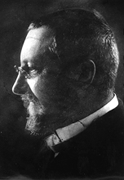
Born July 11, 1851 in Nice, France, Alfred was an only child. His mother, an artist, raised him by herself after a divorce from his father, a physician.
He started studying medicine, but decided to study psychology on his own -- being independently wealthy left him free to do what he pleased! He worked with the psychiatrist Charcot at La Salpetriere, where he studied hypnosis.
In 1891, he moved to Paris to study at the physiological-psychology lab at the Sorbonne, where he developed a variety of research interests, especially, of course, involving individual differences. In 1899, he and his graduate student, Theodore Simon (1873-1961) were commissioned by the French government to study retardation in the French schools, and to create a test to differentiate normal from retarded children.
After marriage, he began studying his own two daughters and testing them with Piaget-like tasks and other tests. This led to the publication of The Experimental Study of Intelligence in 1903.
In 1905, Binet and Simon came out with the Binet-Simon Scale of Intelligence, the first test permitting graduated, direct testing of intelligence. They expanded the test to normal children in 1908, and to adults in 1911.
Binet believed intelligence to be complex, with many factors, and not to be a simple, single entity. He didn’t like the use of a single number as developed by William Stern in 1911 -- the intelligence quotient or IQ. He also believed that, though genetics may set upper limits on intelligence, most of us have plenty of room for improvement with the right kind of education.
He cautioned that his tests should be used with restraint: Even a child two years behind his age level may later prove to be brighter than most! He was afraid that IQ would prejudice teachers and parents, and that people would tend to view it as fixed and prematurely give up on kids who score low early on.
He suggested something he called mental orthopedics: Exercises in attention and thought that could help disadvantaged children “learn how to learn.” He died in 1911, a man way ahead of his time, and wiser than most!
Binet’s fears were well founded. For example, Charles Spearman (1863-1945) introduced the idea that “general intelligence” (g) was real, unitary, and inherited.
Worse were the antics of Henry Goddard (1866-1957). He translated the Binet Simon test into English. He studied a family in New Jersey he named the Kallikaks. Some were normal, but quite a few were “feebleminded” (Goddard’s term). He traced their genealogy to support the heredity position. Because he believed that there was a close connection between feeblemindedness and criminality, he recommended that states institute programs of sterilization of the feebleminded. 20 states passed such laws.
Goddard also tested immigrants, at the request of the Immigration Service. His testers found 40 to 50% of immigrants feebleminded, and they were immediately deported. He also cited particular countries as being more feebleminded than others! Keep in mind that these immigrants rarely spoke much English and were tested during the grueling process of passing through the bureaucracy of Ellis Island after a long ocean voyage in miserable conditions!
Eugenics -- a term coined by Galton -- is the policy of
intentionally breeding human beings according to some standard, and the
sterilization of those that do not meet those standards. It
became an institutionalized reality in 1907, when the Indiana
legislature passed a law that made sterilization of "defectives"
possible. A federal Eugenics Record Office was established in
Cold Spring Harbor, and their lawyers designed law in 1914 that was
promoted as models for the entire country.
Virginia adopted such a law in 1924. Emma Buck, her daughter
Carrie and infant granddaughter Vivian, were judged to be feebleminded,
and their case (Buck vs Bell) was taken before the Supreme Court.
The Supreme Court, under Oliver Wendell Holmes, came down in support of
the sterilization laws. Holmes stated:
"It is better for all the world, if instead of waiting to execute degenerate offspring for crime, or to let them starve for their imbecility, society can prevent those who are manifestly unfit from continuing their kind. The principle that sustains compulsory vaccination is broad enough to cover cutting the Fallopian tubes. Three generations of imbeciles are enough."
Although scientists disputed the reasoning behind the sterilization
laws, 33 states adopted them, and some 65,000 American citizens were
sterilized. The Nazis based their eugenics laws on the American
ones and sterilized 350,000. Eugenics gradually became unpopular
as the horrors of Nazi Germany became public, and gradually ended in
the 1940's. The Supreme Court has yet to reverse its opinion on
the matter, however.
People reading about eugenics and the sterilization laws often think
that this is a great example of how immoral scientists can be. In
reality, the laws were based on biblical passages which say that "like
comes from like," the very same passages used today by creationists.